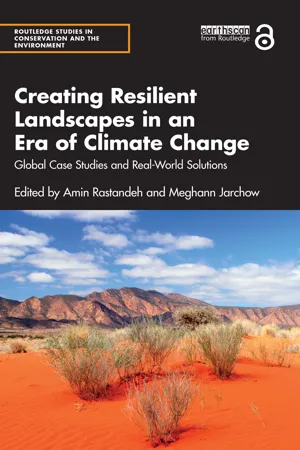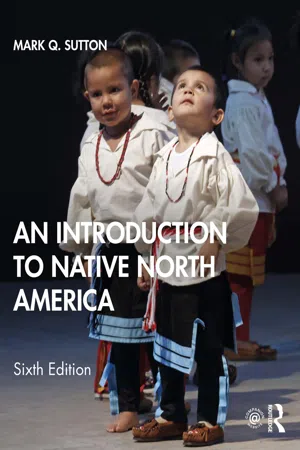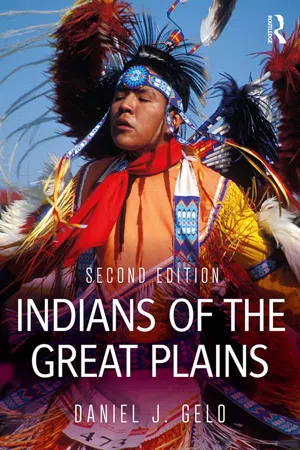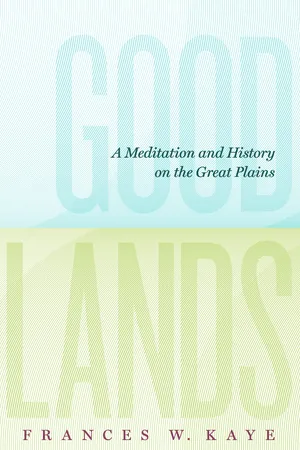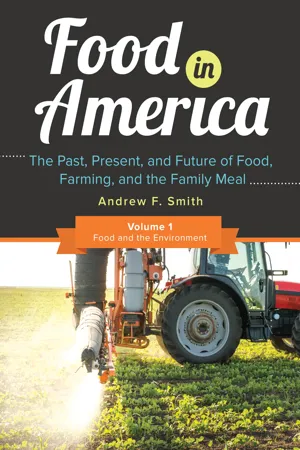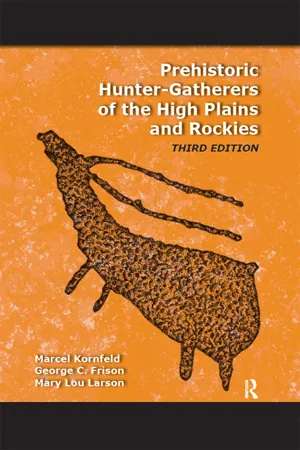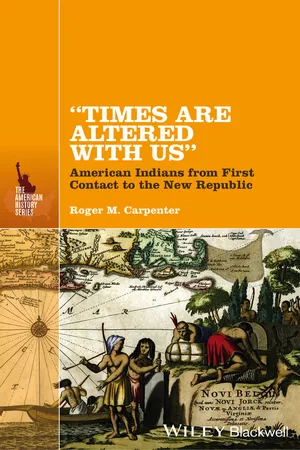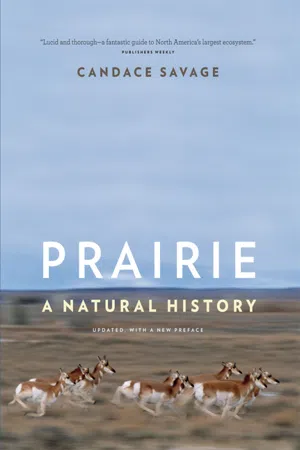History
The Great Plains geography
The Great Plains is a vast expanse of flat grassland covering parts of the United States and Canada. It is characterized by its relatively low relief and lack of trees, making it ideal for agriculture and ranching. The region is known for its extreme weather, including harsh winters and frequent tornadoes, and is home to diverse wildlife and indigenous cultures.
Written by Perlego with AI-assistance
12 Key excerpts on "The Great Plains geography"
- eBook - ePub
Creating Resilient Landscapes in an Era of Climate Change
Global Case Studies and Real-World Solutions
- Amin Rastandeh, Meghann Jarchow, Amin Rastandeh, Meghann Jarchow(Authors)
- 2022(Publication Date)
- Routledge(Publisher)
Figure 5.1 ). The Great Plains tends not to be mapped primarily as an economic or political region. It is instead delineated in terms of a semi-arid climate and flat, sloping, rolling topography, physio-geographic factors shaped by the geologic forces of marine sedimentation, mountain uplift, and erosion, which manifest in ecoregional plant communities and which, in tandem with human sociocultural and economic activities, help determine the region’s agricultural vegetation. At the risk of oversimplifying: the “plains” shape and support the “grassland” of tallgrass, mixed-grass, and shortgrass “prairies.”In the late 1800s, US federal government incentives to encourage settlement westward, such as the Homestead Act, brought many settlers into the Great Plains. With this migration, settlers began converting prairie landscapes into agricultural production through farming and ranching to produce annual grains and livestock (Cunfer & Krausmann, 2015 ). According to the 2011 Atlas of the Great Plains,Throughout the region, more than 80% of the land is used for agricultural activities, including ranching. Only on the margins of the Plains is less than half of the land devoted to agriculture. This pattern emerged in the early 20th century and has continued ever since.(Lavin et al., 2011 , p. 131)The reality of the agricultural landscape that has been built and maintained through settler colonial systems in Indigenous homelands is not the totality of the Great Plains, but given its current dominance, we take it as one important starting point for grappling with questions of resilience. The farming part of this agricultural reality has led to the region being both recognized and mythologized as the “breadbasket,” ecologically vulnerable to drought as during the Dust Bowl1 but nevertheless stocking the world’s granaries with staple grains, with wheat in particular continuing to reign “both on the ground and in the region’s psyche” (Morris, 2011 - eBook - ePub
- Mark Q. Sutton(Author)
- 2021(Publication Date)
- Routledge(Publisher)
10 Native Peoples of the Great PlainsIndians on horseback in feathered headdresses are the most popular image of Native North Americans (e.g., Bird 2018). However, this image was typical only of Great Plains groups, and only became so within the past several hundred years. This simplistic view of Great Plains men has been reinforced by the well-known military resistance of the Great Plains groups and of subsequent public interest (e.g., Hollywood movies) in that aspect of Great Plains culture. In reality, Great Plains societies and peoples were varied and complex.The pre-contact population of the Great Plains was probably rather small, but when horses became available after about 1700, groups already in the region expanded in size while groups from other regions moved into the Great Plains. These factors led to a complicated history and considerable linguistic diversity. Like the other culture areas, the Great Plains also has one defining characteristic: bison hunting.Geography and Environment
Broadly defined, the Great Plains consists of the extensive grasslands that spread across the heartland of North America (see Wedel and Frison 2001). This grassland extends from southern Canada, over about 1,500 miles south, to central Texas, and about 1,000 miles east from the eastern slope of the Rocky Mountains to the Mississippi River Valley (Figure 10.1 ). Due to the rain shadow effect of the Rocky Mountains, relatively little precipitation falls on the Great Plains; water and trees are found only in the river valleys that run east from the Rockies to eventually join with the Mississippi River.The western portion of the Great Plains is a vast area of grassland (consisting of short grass with shallow roots) with little surface water and few trees, commonly referred to as the High Plains - eBook - ePub
- Daniel J. Gelo(Author)
- 2018(Publication Date)
- Routledge(Publisher)
Chapter 1The Great Plains
The Plains landscapeKnowledge of the environment must be the basis for any discussion of Plains Indian culture. In Plains landforms, weather, animals, and plants, we see the origins of Indian migration patterns, adaptations, tools, hunting practices, and house styles. And, it is not too much to say that language, thought, and religious symbolism—elements often included under the term “worldview”—are also influenced by natural surroundings.The early Plains anthropologist Clark Wissler (1870–1947) noted that culture “approaches geographical boundaries with its hat in its hand.” Recognizing the influence of geography or environment on culture requires caution, however. It would be a mistake to think that surroundings strictly determine the cultural development and customs of a people, when humans show great adaptability and their prior customs can persist under new circumstances. Another pitfall is the concept that certain people have a unique relationship to nature resulting from some exclusive mystical or spiritual outlook. It is possible to appreciate Indian knowledge and respect for nature without regarding them as superhuman. Like any environment, the Plains region presents a distinct set of opportunities and limits to the humans who encounter it. Exploring the physical characteristics of the region is a good way to start understanding those who live there.Where and what are the Plains? There have been several attempts to determine the boundaries of the region in geographic and ecological terms. A good starting point is the outline offered by the historian Walter Prescott Webb in his classic work The Great Plains (1981; orig. 1931). Webb tells us that a plains environment has three characteristics: 1) it is a comparatively level surface of great extent; 2) it is unforested; and, 3) its rainfall is not sufficient for ordinary intensive agriculture. In North America, a level surface extends for the most part between the Appalachian and Rocky Mountains. The unforested area of the continent, however, is mostly west of the Mississippi. It begins at the timber line, an artificial boundary where deep woods yield to brush and grass, running on the east generally between the 94th and 98th meridians (east Texas and Oklahoma, western Missouri and Minnesota) but veering east to the 87th meridian around 40°N, or the area around Iowa and Illinois. Not counting the timber of the Rocky Mountains, this unforested zone extends west to the Sierras and Coast ranges of California, Oregon, and Washington. The dry zone of the continent extends from the 20-inch rainfall line, the so-called humid line - Loretta Fowler(Author)
- 2003(Publication Date)
- Columbia University Press(Publisher)
Part I History and CulturePassage contains an image CHAPTER 1 Introduction
The Great Plains is a land of sun, wind, and grass stretching 1,500 miles north to south from the Prairie Provinces of Canada to west central Texas and about 1,000 miles east from the base of the Rocky Mountains. Regions within the Plains vary in environmental conditions to the extent that five areas can be identified: the Southern Plains (today, roughly far eastern New Mexico, north central Texas, and west central Oklahoma); the Central Plains (roughly eastern Colorado, Kansas, far western Missouri, Nebraska, and far western Iowa); the Middle Missouri (roughly west central North and South Dakota); the Northeastern Periphery (the boundary of which has fluctuated over time with changing environmental conditions, but which is roughly eastern North and South Dakota, southwestern Minnesota, southern Manitoba, and southeastern Saskatchewan); and the Northwestern Periphery (the boundary of which has also fluctuated, but which is roughly northern and eastern Wyoming, most of eastern Montana, southeastern Alberta, and southwestern Saskatchewan). This is a vast, semi-arid, and generally treeless grassland, the elevation of which gradually decreases from west to east. The lack of trees gives high-velocity winds a free sweep, which has a drying effect. This upland steppe region is covered with shallow-rooted short grasses that provide good winter forage and a variety of flowering plants that survive with little rain. The short grass in the uplands gives way to mixed and deeply rooted tall grasses in the lower prairie elevations. On the northern edge of the Plains, the tall grass grades into a forested parkland; to the east of the Plains are woodlands. Along the watercourses, such as the Missouri River, which begins in the Rocky Mountains and flows into the Mississippi River, belts of forest two to ten miles wide once provided a home for woodland animals, as well as a wide variety of plants.1- 1 All regions are imaginary—the sharp borderlines and different coloured spaces of the map are intellectual constructs, not physiographic ones—but, like most imaginary human constructs, maps control some of the ways human minds can conceptualize, in this case, place. If we look again at our particular map of the Great Plains, we can see that its outlines are an amalgam of physiographic and political features. On the land itself, elevation gradually rises and average annual precipitation gradually drops from east to west, while summer temperatures rise and summer daylight hours diminish from north to south across the Great Plains. Both native vegetation and contemporary cropping patterns spill over the edges of the region in all directions. Rural areas of the Great Plains share with the rest of rural North America, and indeed the world, problems such as depopulation, loss of political power, soil and water degradation, siting of material and human “waste” facilities, and low and uncertain commodity prices. Urban Great Plains centres are indistinguishable in their Wal-Marts, fast food franchises, and drug problems from other North American cities. Yet the variability across its area and the indistinct boundaries of the Great Plains do not negate the value of discussing it as “region” in order to structure our understanding of the political and economic tug-of-wars that have characterized this place and are rendering the rural areas—the vast majority of the land—socially and demographically unviable, except for the growing populations and high birth rates on reserves and reservations.Let us look briefly at the geographical and human history that does unify the Great Plains and enables us to speak of it as a region that is more meaningful than either a single state or province or the larger and far more amorphous region designated “the West.” As we noted, about 65 million years ago, the great tectonic plates on which the continents ride ground together in the Laramide orogeny, pushing up the Rocky Mountains. The soil of the plains is largely derived from the weathering away of the Rockies by wind, water, and frost, and the deposition of soil wherever the wind or water slows down enough to drop individual grains. Because the prevailing winds come from the west, they tend to shed most of their water on the west side of the mountains, since the air cools and condenses out moisture as the winds rise to pass over the obstruction. The resulting rain shadow east of the Rockies determines the semi-arid nature of the plains. Glaciation, the recession of the glaciers, and the concentration of meltwater in ancient Lake Agassiz (whose remnants are Lakes Winnipeg, Manitoba, and Winnipegosis) repeatedly flattened the region, but also decorated it with ancient shorelines, lateral and terminal glacial moraines, and prairie pothole lakes, formed where chunks of ice surrounded by glacial till melted, leaving holes in the till. The Black Hills and Cypress Hills became stone islands in the seas of ice, providing refuge for a variety of species: even today, they support different flora and fauna from the surrounding plains. Huge deep beds of gravel underlie the smooth surface of the prairies: like sponges, they collect water as it flows through the flat, braided rivers of the plains south of the Missouri and seeps down to aquifers, particularly the Ogallala Aquifer, which underlies the land from Nebraska’s sandhills to the Llano Estacado of Texas. The deep, dark soils of the Great Plains, an annual average precipitation of nine to twenty inches (17 to 50 cm), and frequent lightning-caused fires allowed a characteristic vegetation of grasses and associated forbs to evolve, along with gallery forests along riverbanks and ravines.2
- eBook - ePub
Food in America
The Past, Present, and Future of Food, Farming, and the Family Meal [3 volumes]
- Andrew F. Smith(Author)
- 2017(Publication Date)
- ABC-CLIO(Publisher)
By the Great Plains is meant, in general, an area stretching from west central Texas to the border of Canada, definitely bounded on the west by the Rocky Mountains, more irregularly delimited on the east near the 100th meridian, where, before settlement by the white man, the “short grass” country merged gradually with the “tall grass,” or prairie, country. The critical area now under discussion excludes southwestern Texas but includes the Texas Panhandle, the Oklahoma Panhandle, northeastern New Mexico, and all the northern portion of the Plains. The area may again be divided, by a line run midway east and west across Kansas and eastern Colorado, into the Northern Plains and the Southern Plains.The entire region is marked by a low annual rainfall, often concentrated in storms of short duration and great intensity, by wide fluctuations of temperature, and by prevailing winds not equaled in average strength anywhere in the United States except along the sea coasts. The soil is derived mainly from old water transported material, with some areas of drifting sand. In the North the Bad Lands of South Dakota are evidence of extensive prehistoric erosion, but the longer winters, protecting the ground by frost and snow, have made wind erosion a somewhat less serious danger in the North than in the South. In the South much sandy soil is naturally unstable and the finer grained soil becomes loose and unstable with exhaustion of the humus supply by continuous cultivation. These lands have been held in place chiefly by such natural growths as buffalo grass and grama grass.One primary source of disaster has been the destruction of millions of acres of this natural cover, an act which in such a series of dry years as that through which we are now passing left the loose soil exposed to the winds. This destruction has been caused partly by over grazing, partly by excessive plowing. It has been an accompaniment of settlement, intensified in operation and effect since the World War. . . . As the ranges were enclosed feed crops were raised to fatten stock, requiring intensive cultivation, and the ranges themselves were overstocked. Thus there was not only a progressive breaking up of the native sod but a thinning out of the grass cover on lands not yet plowed. - eBook - ePub
- Pamela Riney-Kehrberg, Pamela Riney-Kehrberg(Authors)
- 2016(Publication Date)
- Routledge(Publisher)
58 The people love the land, have faith in it, and in themselves. At times this belief has made them overly optimistic, even foolish. But it has also made them innovative and dedicated, ready to adapt to whatever new challenges the future holds.The Great Plains, therefore, is a region where much is present: grass, land, wind, space, fire, openness, people, possibility, and even (some) water. If so, why does the superficial, dismissive, and often negative characterization of the region linger? It is because for much of its history occupants of, as well as visitors to, the Great Plains have laid eyes on all that space, felt both the freedom and the fear that it communicates, and immediately vowed to change it. The Great Plains is a region that, even more than other environments, is constantly being re-made, both in reality and in peoples’ minds. Throughout its history, the grassland has been important not for what it was or is, but for what it might be (the Imagined Plains). What’s not there is therefore defining because its absence means possibility. “Empty” space, in other words, translates to an obligation to transform, to shape. What’s already there (the present) is never enough. For many people, the open space of the Plains is overwhelming—like a long, awkward pause in a conversation. It must be filled . . . or flown-over . . . or dismissed as irrelevant. Space is scary.Beyond filling the awkward space, the way we write about filling the awkward space is important. Too often, the stories perpetuate the assumption that what is actually present is not adequate. Historian William Cronon notes that the narrative of Plains history is often told, unfortunately, as a progressive story—the prairie transformed into farms, ranches, and homes. For this transformation to occur, however, in the story telling, the “earlier form of that landscape must either be neutral or negative in value. It must deserve to be transformed.”59 - eBook - ePub
- Marcel Kornfeld, George C Frison, Mary Lou Larson(Authors)
- 2016(Publication Date)
- Routledge(Publisher)
1THE NORTHWESTERN PLAINS AND THE CENTRAL ROCKY MOUNTAINSAn Ecological Area for Prehistoric Hunters and GatherersINTRODUCTIONThe Great Plains of North America constitute a large share of the continent, extending north and south from well into Canada to the border of Mexico and from the base of the Rocky Mountains on the west to the Eastern Woodlands (Wedel 1961:20–45). The Rocky Mountains likewise extend from northern Canada to Mexico and from their eastern boundary with the Great Plains to their more diffuse western boundary with the Northwest Plateau, Great Basin, and other physiographic regions. Actual boundaries between the Plains and Rocky Mountains are somewhat flexible, depending on the reactions to the area by the particular observer. There are some places where one can almost point to a line separating the Rocky Mountains and the Plains. Elsewhere on the western border of the Plains, mountain ranges extend deep into the Plains and often form intermontane basins, obscuring the line of demarcation. This is especially true in the case of the Central Rocky Mountain region. The eastern boundaries of the Plains are even less distinct, since there is none of the contrast formed by mountain slope and flat plain. Rainfall generally increases gradually to the east across the Plains, accompanied by lushness of the flora; the same is true with increasing elevation in the mountains. There is no sharp line of demarcation separating short-grass plains from tall-grass plains and the latter from Eastern Woodlands. Both short- and long-term changes in annual precipitation cause these boundaries to shift from time to time (Wedel 1961:20–45).The seasoned Plains traveler can always detect the subtle difference that identifies the Plains. Prehistorically, the area was at the periphery of eastern cultural developments such as Hopewellian and Mississippian, but both influenced the peoples of the Northwestern Plains. Rainfall, frost-free days, and the available technology apparently held back the development of agriculture, limiting Plains horticultural efforts mostly to the floodplains of the rivers on the eastern margins. The Plains villagers living there may have been on the threshold of greater cultural developments when their efforts were disrupted by European incursion. - eBook - ePub
"Times Are Altered with Us"
American Indians from First Contact to the New Republic
- Roger M. Carpenter(Author)
- 2015(Publication Date)
- Wiley-Blackwell(Publisher)
Largely a windswept sea of hardy grasses whose extensive root systems enabled them to thrive in a region that saw little rainfall, the Great Plains stretch from the margins of the subarctic regions of Saskatchewan and Manitoba in the north, to the semiarid lands where Texas and the Northern Mexican Desert meet. Bordered on the west by the foothills of the Rockies and almost brushing the Mississippi River to the east, nineteenth-century American farmers would be stunned to learn just how hardy these grasses and their tramped-down root systems were, when they made their first – and usually failed – attempts to break the turf, or “bust the sod,” of the Great Plains with their plows.In the years prior to contact with Europeans, relatively few people lived on the Great Plains. The ancestors of native peoples often went there to hunt, but few lived there year-round. Semiarid, the region saw hot, unpleasant summers, and the flatness of the land, which offered few windbreaks unless one settled in one of the protected river valleys, only made worse the bitter cold of the winters. Generally speaking, two groups of native peoples populated the Great Plains in the pre-contact period. One consisted primarily of settled peoples who largely farmed, living in permanent villages in the river valleys that sheltered them from the winds of the plains. The spring floods deposited alluvial soils along the river banks, which the farmers, who lived in earthen lodges, transformed into fertile fields of maize, beans, and squash.The other peoples of the plains consisted mainly of nomads who spent much of their summers following the bison herds and living in small skin tepees. Many of these nomads did not live on the plains year-round; most lived in other regions, such as the Eastern Woodlands or the Great Basin, to which they returned from their plains hunting grounds before the arrival of winter. From necessity, their teepees had to be small because pre-contact Native Americans had nothing on the order of European draft animals – such as the ox or the horse – that could be harnessed to move their possessions. Generally, native people packed their teepees – and everything else they owned – onto a travois - eBook - ePub
- Ellen E. Wohl(Author)
- 2009(Publication Date)
- University Press of Colorado(Publisher)
The C 3 cool season grasses, such as needle-and-thread and western wheatgrass, that are more common on the northern Great Plains produce seed early in the summer before temperatures reach their annual maximum. Survival of all species of grasses improves in stands of mixed C 3 and C 4 plants that exert their maximum demand on scarce water supplies during different phases of the growing season. Slender wheatgrass at the Fromme Prairie. The grasses of the Great Plains must conserve water so carefully because the combined effects of geologic history and atmospheric circulation allow very little precipitation to reach the grasslands during much of the year. What Edwin James described in 1819 as “that great Sandy Desert, which stretches eastward from the base of the Rocky Mountains” 9 to the Platte River, results from two simple facts: the dominant movement of air across the planet is from west to east, and western North America is very mountainous. To fully understand these effects, we must look back into the unimaginably long spans of geologic history DEEP TIME Geologists commonly refer to the center of North America as the stable craton. The craton is the Earth’s oldest geologic province and covers most of Canada and the central half of the continental United States. The region has been without mountain building, metamor-phism, or volcanism—all the surface signs of the Earth’s restless interior—for more than a billion years. At the foundation of the craton is the basement composed of crystalline rocks that record a more exciting time in the geologic history of what is now central North America. The basement is a mosaic of rocks created in ancient volcanic island arcs and other fragments of the Earth’s crust that collided with one another to form the nucleus of what is now North America. These collisions and coalescences occurred between approximately 3 billion and 1.5 billion years ago, reaching a crescendo during the Great Plains Orogeny of 1.8 to 1.6 billion years ago - eBook - ePub
Prairie
A Natural History
- Candace Savage(Author)
- 2011(Publication Date)
- Greystone Books(Publisher)
The trick is that the south-to-north gradient in precipitation is canceled out by an equal but opposite north-to-south gradient in evaporation. Because the average annual temperature increases from north to south, so does the rate at which moisture is lost through evaporation. Whatever the southern plains gain as rain, they lose as water vapor. As a result, the “effective precipitation”— the amount of water that is available to growing plants—is about the same in southern Alberta as in northern Texas. This helps to explain the long, gradual transition from the semiarid climate of the Northwestern Short/Mixed Grasslands to the sun-frazzled conditions of the Southern Short Grasslands. (A map showing these ecoregions can be found.)Raindrops cling to the translucent petals of a harebell, a flower that is native not only to the northern Great Plains but to parts of Europe as well, where it is famous as the bluebell of Scotland.Meanwhile, there is yet another climatic gradient that also helps to shape the vegetational profile of the Great Plains. This is an east-to-west decline in average annual precipitation. The tropical air that brings summer rains to the prairies typically swings up from the Gulf of Mexico, through the central United States, and off toward the east. As a result, its influence is stronger on the tall grasslands of the eastern plains than on the short-to-mixed grasslands farther west. If Winnipeg receives about 20 inches (500 millimeters) of moisture on average, Lethbridge gets 20 percent less (just 16 inches, or 400 millimeters). And if Kansas City can count on almost 40 inches (1 meter) of precipitation in a normal year, Amarillo can only expect to receive about half as much—and this time there is no reverse gradient in temperature to compensate for the difference. Less moisture is simply less.In the days before the prairies were plowed and settled, this east-west moisture gradient found expression in the natural vegetation. As the average precipitation declined toward the west, the vegetation diminished in step, gradually reducing in height like a living bar graph. Somewhere around 100 degrees west longitude (give or take a few degrees), the tall-grass species dwindled away, leaving the wind to ripple through knee-high stands of mixed-grass prairie. To the west and southwest, the midheight grasses in turn gave way to a carpet of ground-hugging grasses, as a dry land clothed itself in drought-resistant plants.The boundaries between tall-, mixed-, and short-grass prairies are not as tidy as they look on the map. In the patchwork quilt of the grasslands, each of the major blocks of vegetation is composed of many smaller blocks. And just as the overall picture is determined by large-scale climatic patterns, so each of these distinctive patches is a response to local variations in microclimate. Conditions are different on a south-facing slope than on the north and on lowlands than on hilltops, and these subtle differences are reflected in the vegetation. Moving uphill, from humid bottomlands to the drier crest, reproduces the moisture gradient of moving from east to west. And so, a sea of tall-grass prairie is broken by islands of mixed (or even short) grasses that grow on uplands and arid slopes. Meanwhile, out on the short-grass prairie, blue grama and its diminutive associates follow the opposite trend, ceding ground to mid-height or tall grasses in moist valley bottoms. - eBook - ePub
- Dennis Ojima, Jean Steiner, Shannon McNeeley, Karen Cozzetto, Amber Childress(Authors)
- 2015(Publication Date)
- NCA Regional Input Reports(Publisher)
Many taxa of biota, including plants, insects, and birds, have evolved the capacity to adapt to gradual environmental changes associated with climate, primarily through movement to more favorable areas. An exception to this is the mass extinction of large terrestrial mammals (North American megafauna, including mammoths, mastodons, ground sloths, horses, camels, and others) during the late Pleistocene (ca 11,500-10,500 bp). Although heavily debated, a primary hypothesis for the cause of these abrupt extinctions is the combination of human predation (the arrival of Clovis hunters to North America) coincident with major climatic and environmental changes that had already reduced population sizes (Benedict et al. 1996, Stuart 2008).WATER RESOURCESBy virtue of its scarcity, water is a critical resource in the Great Plains. Although the region is characteristically dry, humans have managed to transform the land to overcome this limitation. Since water has been a central component of that transformation, a continuous, sufficient water supply is a major concern to inhabitants. Water supply sources include surface water in rivers, streams and lakes, which comes primarily from snowmelt, shallow and deep aquifers, and rain. Drought has always been a factor in the region, with the degree and timing controlled by temperature, precipitation, and the ratio of precipitation to potential evapotranspiration (PET) (Parton et al. 1994). Barry (1983) argues that drought is the key climatic parameter of the Great Plains, as it determines the carrying capacity of the region. Water users in the Great Plains are concerned about a variety of factors related to climate variability and change. Climate change is not the most important concern in this region now, however, as there are many other stresses, including market-driven factors, policy factors, and social factors. In fact, many water users in this region are vulnerable due to the declining reward scale for farming and ranching.
Index pages curate the most relevant extracts from our library of academic textbooks. They’ve been created using an in-house natural language model (NLM), each adding context and meaning to key research topics.
Explore more topic indexes
Explore more topic indexes
1 of 6
Explore more topic indexes
1 of 4
